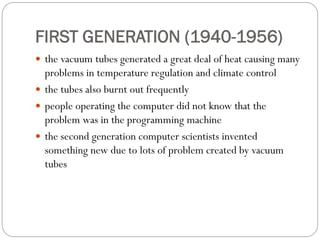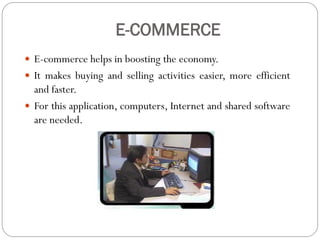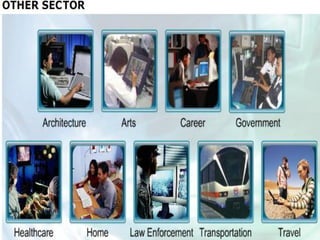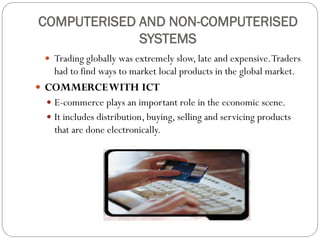History and Introduction to Information and Communication Technology
- 1. Lecture 1 Lecturer: Nareena Introduction to Information and Communication Technology
- 2. Introduction to Information and Communication Technology ICT is technology required for information processing, in particular, the use of computers, communication devices and software application to convert, store, protect, process, transmit and retrieve information from anywhere, anytime.
- 3. Introduction to Information and Communication Technology (cont.) Information Knowledge obtained from reading, investigation, study or research. Tools to transmit information are the telephone, television and radio.
- 4. Introduction to Information and Communication Technology (cont.) Information is knowledge and helps us to fulfill our daily tasks Such as, forecasting the stock exchange market. Communication Act of transmitting messages.
- 5. Introduction to Information and Communication Technology (cont.) Information is exchanged between individuals using symbols signs or verbal interactions. These older forms of communication are less utilized as compared to the use of the Internet, e-mail or video conferencing. Communication is important in order to gain knowledge. More confident in expressing our thoughts and ideas.
- 6. Introduction to Information and Communication Technology (cont.) Technology Use of scientific knowledge, experience and resources to create process products that fulfill human needs. It is vital in communication
- 12. COMPUTER GENERATIONS FIRST GENERATION (1940-1956)
- 14. FIRST GENERATION (1940-1956) the vacuum tubes generated a great deal of heat causing many problems in temperature regulation and climate control the tubes also burnt out frequently people operating the computer did not know that the problem was in the programming machine the second generation computer scientists invented something new due to lots of problem created by vacuum tubes
- 15. SECOND GENERATION (1956-1963) The creation of transistor spark the production of a wave Transistor was small devices use to transfer electronic signals across a resister. Transistors had many advantages compared to other hardware technology.
- 16. SECOND GENERATION (1956-1963)(cont.) transistors were smaller than vacuum tubes they needed no warm up time consumed less energy generated much less heat faster and more reliable
- 17. THIRD GENERATION (1964-1971) IBM 370 series were introduced in 1964. It came in several models and sizes. It was used for business and scientific programs. Silicone chips were manufactured in 1961. Then came the integrated circuit technology, which had reduced the size and cost of computers.
- 18. THIRD GENERATION (1964-1971)(cont.) Silicone chips were reliable, compact and cheaper. Sold hardware and software separately which created the software industry. Customer service industry flourished (reservation and credit checks)
- 19. FOURTH GENERATION (1971-PRESENT) It took only 55 years for the 4 generations to evolve. The growth of the computer industry developed technologies of computer inventions. There are many types of computer models such as: Apple Macintosh IBM DELL ACER
- 20. FOURTH GENERATION (1971-PRESENT) In 1971 Intel created the first microprocessor. In 1976, Steve Jobs built the first Apple computer. In 1981, IBM introduced its first personal computer.
- 21. FOURTH GENERATION (1971-PRESENT) Hardware technology such as silicone chips, microprocessor and storage devices were invented. A microprocessor is a specialized chip which is developed for computer memory and logic. Microprocessor is a large-scale integrated circuit which contained thousands of transistors. The transistors on this one chip are capable of performing all of the functions of a computer's central processing unit.
- 22. FOURTH GENERATION (1971-PRESENT) Advantages Computers became 100 times smaller than ENIAC (Electronic Numerical Integrator and Computer) the first computer Gain in speed, reliability and storage capacity Personal and software industry boomed
- 23. FIFTH GENERATION (PRESENT & BEYOND) Computers are technologically advance and are still being development to become more efficient. The inventions of new hardware technology in the fifth generation have grown rapidly including Other modern computer devices such as : silicone chips processor robotics virtual reality intelligent systems programs which translate languages
- 24. NEW ERA COMPUTER
- 25. USAGE OF ICT IN DAILY LIFE EDUCATION
- 27. BANKING The computer is the nerve centre of the banking system around the world. It functions to control the entire banking system that also includes 'Electronic Banking Services‘. Electronic banking provides 24 hour services. AutomatedTeller Machine (ATM) Cheque Deposit Electronic FundTransfer Direct Deposit Pay by phone system Internet banking
- 28. BANKING In the banking sector, customers, businessman and bank administrator benefits from the usage of ICT.
- 29. INDUSTRY Computers are used to facilitate production planning and control systems, to support chain management and to help in product design in the industrial sector.
- 31. E-COMMERCE E-commerce helps in boosting the economy. It makes buying and selling activities easier, more efficient and faster. For this application, computers, Internet and shared software are needed.
- 34. COMPUTERISED AND NON-COMPUTERISED SYSTEMS COMPUTER SYSTEM A system is an arrangement of elements that when it is put together it becomes an organized and established procedure. A system typically consists of components connected together in order to facilitate the flow of information, matter or energy. A computer system consists of a set of hardware and software which processes data in a meaningful way.
- 35. COMPUTERISED AND NON-COMPUTERISED SYSTEMS EDUCATION education is the science of teaching and learning of specific skills it also imparts knowledge, good judgment and wisdom
- 36. COMPUTERISED AND NON-COMPUTERISED SYSTEMS BANKING SYSTEM BANKING BEFORE ICT banking was done manually by taking deposits directly transactions can only be made during working hours takes time to approve any loan applications BANKINGWITH ICT all transactions are done by computers transaction can be done at anytime and place online services, phone banking system, credit cards are available
- 37. COMPUTERISED AND NON-COMPUTERISED SYSTEMS INDUSTRY INDUSTRY BEFORE ICT Production was slow because everything was done manually and totally depended on human labour. INDUSTRYWITH ICT Computers and telecommunications industry became profitable since production can be increased through an all day operation.
- 38. COMPUTERISED AND NON-COMPUTERISED SYSTEMS COMMERCE Commerce is an activity of exchanging, buying and selling of commodities on a large scale involving transportation from place to place. COMMERCE BEFORE ICT Trading was made using the barter system and it was then later developed into currency. Advertisement was in the form of word of mouth, billboards and printed flyers.
- 39. COMPUTERISED AND NON-COMPUTERISED SYSTEMS Trading globally was extremely slow, late and expensive.Traders had to find ways to market local products in the global market. COMMERCEWITH ICT E-commerce plays an important role in the economic scene. It includes distribution, buying, selling and servicing products that are done electronically.







































